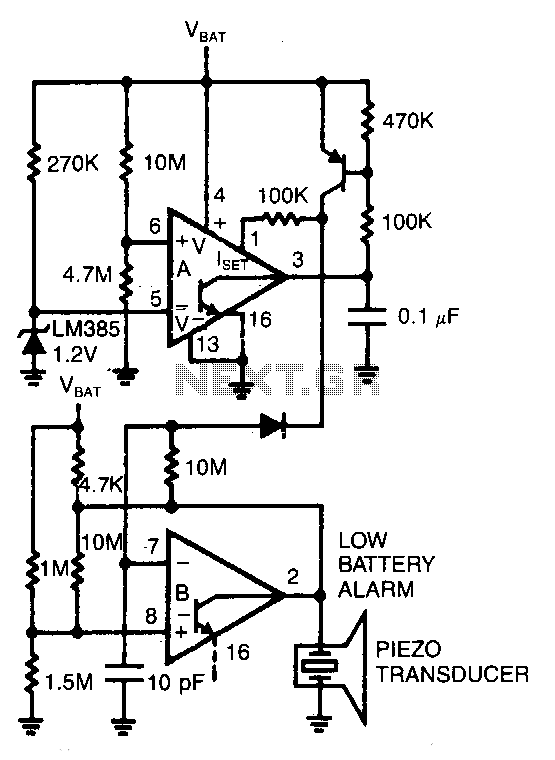
Low-battery-detector

Comparator A detects when the supply voltage drops to 4 V and enables comparator B to drive a piezoelectric alarm. More: Is: 6V at 45μA, Is: 3.8V at 1μA, f: 3kHz
The circuit utilizes two comparators to monitor supply voltage levels and activate an alarm system. Comparator A is set to trigger when the voltage drops to 4 V. This threshold is critical for ensuring the system operates within safe voltage levels. When the voltage falls below this threshold, Comparator A outputs a signal that enables Comparator B.
Comparator B is responsible for driving a piezoelectric alarm, which serves as an alert mechanism. The piezoelectric alarm is chosen for its efficiency and ability to generate sound with minimal power consumption. The output from Comparator B activates the alarm, alerting users to the low voltage condition.
The circuit specifications indicate that the input sensitivity (Is) is 6 V at 45 μA and 3.8 V at 1 μA. This suggests that the comparators are designed to operate effectively within a range of current levels, ensuring reliable performance. The operational frequency of the circuit is noted to be 3 kHz, which indicates the speed at which the comparators can respond to changes in voltage.
Overall, this circuit design is effective for monitoring voltage levels and providing an alert through a piezoelectric alarm, making it suitable for applications where low voltage conditions need to be detected promptly.Comparator A detects when the supply voltage drops to 4 V and enables comparator B to drive a piezoelectric alarm. Is: 6V at 45uA, Is: 3.8V at luA, f: 3kHz
The circuit utilizes two comparators to monitor supply voltage levels and activate an alarm system. Comparator A is set to trigger when the voltage drops to 4 V. This threshold is critical for ensuring the system operates within safe voltage levels. When the voltage falls below this threshold, Comparator A outputs a signal that enables Comparator B.
Comparator B is responsible for driving a piezoelectric alarm, which serves as an alert mechanism. The piezoelectric alarm is chosen for its efficiency and ability to generate sound with minimal power consumption. The output from Comparator B activates the alarm, alerting users to the low voltage condition.
The circuit specifications indicate that the input sensitivity (Is) is 6 V at 45 μA and 3.8 V at 1 μA. This suggests that the comparators are designed to operate effectively within a range of current levels, ensuring reliable performance. The operational frequency of the circuit is noted to be 3 kHz, which indicates the speed at which the comparators can respond to changes in voltage.
Overall, this circuit design is effective for monitoring voltage levels and providing an alert through a piezoelectric alarm, making it suitable for applications where low voltage conditions need to be detected promptly.Comparator A detects when the supply voltage drops to 4 V and enables comparator B to drive a piezoelectric alarm. Is: 6V at 45uA, Is: 3.8V at luA, f: 3kHz